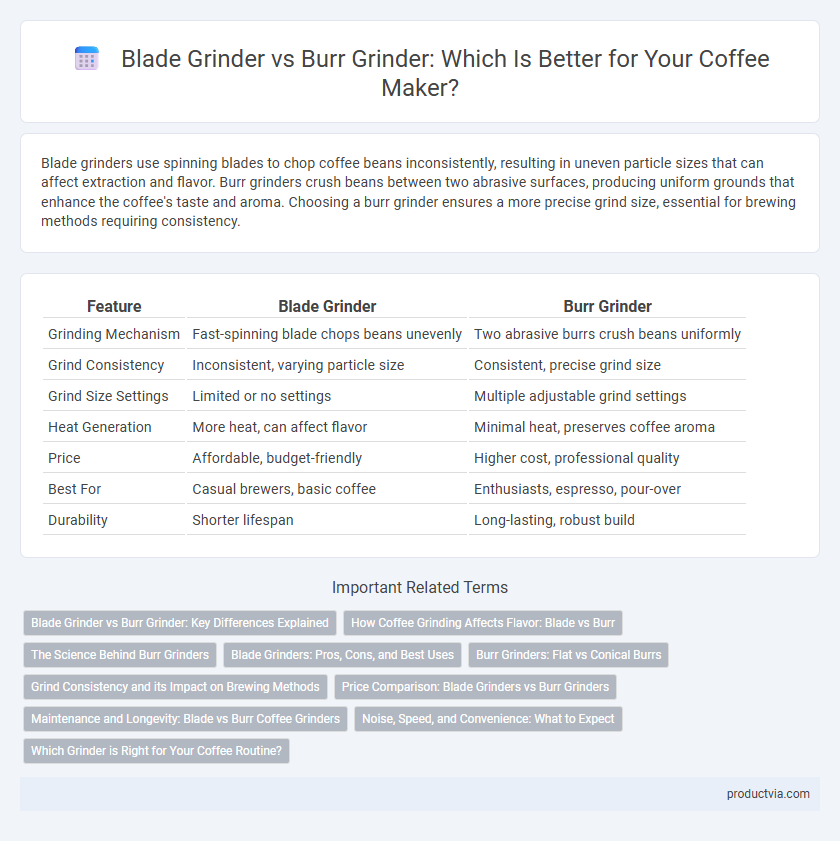Blade grinders use spinning blades to chop coffee beans inconsistently, resulting in uneven particle sizes that can affect extraction and flavor. Burr grinders crush beans between two abrasive surfaces, producing uniform grounds that enhance the coffee's taste and aroma. Choosing a burr grinder ensures a more precise grind size, essential for brewing methods requiring consistency.
Table of Comparison
| Feature | Blade Grinder | Burr Grinder |
|---|---|---|
| Grinding Mechanism | Fast-spinning blade chops beans unevenly | Two abrasive burrs crush beans uniformly |
| Grind Consistency | Inconsistent, varying particle size | Consistent, precise grind size |
| Grind Size Settings | Limited or no settings | Multiple adjustable grind settings |
| Heat Generation | More heat, can affect flavor | Minimal heat, preserves coffee aroma |
| Price | Affordable, budget-friendly | Higher cost, professional quality |
| Best For | Casual brewers, basic coffee | Enthusiasts, espresso, pour-over |
| Durability | Shorter lifespan | Long-lasting, robust build |
Blade Grinder vs Burr Grinder: Key Differences Explained
Blade grinders use flat, spinning blades to chop coffee beans, resulting in uneven particle sizes that can affect flavor extraction. Burr grinders crush beans between two abrasive surfaces, producing consistent grind sizes that enhance brewing precision and coffee taste. Choosing a burr grinder over a blade grinder improves grind uniformity and overall coffee quality.
How Coffee Grinding Affects Flavor: Blade vs Burr
Blade grinders chop coffee beans unevenly, causing inconsistent particle sizes that lead to over-extraction or under-extraction, resulting in bitter or sour flavors. Burr grinders crush beans uniformly, promoting even extraction and enhancing the coffee's inherent flavor profile by preserving aromatic oils. Consistent grind size from burr grinders produces a balanced, smoother cup compared to the variable grind and flavor often found with blade grinders.
The Science Behind Burr Grinders
Burr grinders use two revolving abrasive surfaces to crush coffee beans uniformly, producing consistent particle size essential for optimal extraction. Scientific studies demonstrate that uniform grind size from burr grinders enhances flavor clarity and reduces over-extraction or under-extraction compared to the uneven particles produced by blade grinders. Precise control over grind size with burr grinders aligns with the extraction variables critical in brewing methods like espresso and pour-over.
Blade Grinders: Pros, Cons, and Best Uses
Blade grinders offer an affordable and straightforward solution for coffee grinding, using fast-spinning blades to chop beans unevenly. While they provide quick grinding suitable for drip coffee makers and French presses, the inconsistent grind size can lead to unpredictable extraction and bitterness. Best used for occasional brewing or for those new to home coffee grinding, blade grinders require careful timing to avoid overheating or overgrinding the beans.
Burr Grinders: Flat vs Conical Burrs
Burr grinders offer superior consistency compared to blade grinders by crushing coffee beans between two abrasive surfaces. Flat burr grinders provide a uniform particle size ideal for espresso brewing, while conical burr grinders excel in versatility and produce less heat, preserving the beans' flavor and aroma. Choosing between flat and conical burrs depends on the desired grind size precision and flavor profile for the brewing method.
Grind Consistency and its Impact on Brewing Methods
Blade grinders produce uneven particle sizes, leading to inconsistent extraction and less control over brewing variables. Burr grinders offer uniform grind consistency, crucial for methods like espresso and pour-over that demand precise extraction. Consistent grind size from burr grinders enhances flavor clarity and reduces bitterness across all brewing techniques.
Price Comparison: Blade Grinders vs Burr Grinders
Blade grinders are generally more affordable, with prices typically ranging from $15 to $40, making them a budget-friendly option for casual coffee drinkers. Burr grinders, while more expensive, usually cost between $50 and $300, reflecting their superior grind consistency and enhanced flavor extraction. Investing in a burr grinder can significantly improve coffee quality despite the higher initial cost.
Maintenance and Longevity: Blade vs Burr Coffee Grinders
Blade grinders require frequent cleaning to prevent coffee residue buildup, but their simpler design often leads to quicker wear and shorter lifespan compared to burr grinders. Burr grinders feature more durable components and can be disassembled for thorough cleaning, enhancing their longevity and consistent performance. Proper maintenance of burr grinders, including regular burr replacement, significantly extends the grinder's functional life and preserves grind quality over time.
Noise, Speed, and Convenience: What to Expect
Blade grinders produce more noise and operate at higher speeds, often leading to uneven coffee grounds, while burr grinders function more quietly with consistent speed for uniform grinding. Burr grinders offer greater convenience by allowing adjustable grind sizes, providing better control for different brewing methods. Noise levels and grinding efficiency make burr grinders preferable for a quieter, more precise coffee-making experience.
Which Grinder is Right for Your Coffee Routine?
Blade grinders offer an affordable and compact option ideal for casual coffee drinkers who prefer quick and simple grinding, but they produce inconsistent particle sizes affecting flavor extraction. Burr grinders provide precise, uniform grounds and adjustable settings, making them the preferred choice for coffee enthusiasts seeking control over grind size to optimize brewing methods like espresso or French press. Consider your coffee preferences, budget, and brewing style to determine whether the consistency of a burr grinder or the convenience of a blade grinder suits your coffee routine best.
Blade grinder vs Burr grinder for coffee grinding Infographic

 productvia.com
productvia.com